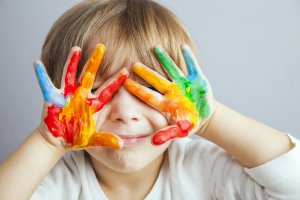Identifying and Developing Children's Talents

All people are good at something. But sometimes it’s difficult for them to know where they stand out. In this regard, it’s important for children to identify what their strengths are from a young age so they can properly develop them. In other words, detecting and developing children’s talents is important. This way, they’ll grow happy and fulfilled.
But do you know what we mean by “talent”? Over the years, many authors have addressed this concept and have formulated multiple definitions of it. In this article, we’ll focus on Howard Gardner’s perspective.
“I really believe that everyone has a talent, ability, or skill that he can mine to support himself and to succeed in life.”
– Dean Koontz –
What’s talent?
According to psychologist Howard Gardner, talent is:
“A biopsychological potential to process information that can be activated in a cultural setting to solve problems or create products that are of value in a culture.”

Furthermore, according to Gardner, human talent is developed based on eight areas or intelligences:
- Verbal-linguistic. The ability to understand words and languages. People with this intelligence are typically good at reading, writing, telling stories, and memorizing words along with dates.
- Visual-spatial. The ability to recognize and manipulate patterns, large spaces, and smaller spaces.
- Musical-rhythmic and harmonic. The ability to interpret, compose, and learn musical patterns.
- Bodily-kinesthetic. The ability to use the body as a means to solve problems or, also, to create products.
- Logical-mathematical. The ability to analyze and solve problems using logic and carrying out research in a scientific way.
- Naturalistic. The ability to distinguish, classify, and use elements (objects, animals, plants, and minerals) from the environment, urban or rural.
- Intrapersonal. The ease of understanding oneself, knowing one’s own desires, fears, and strengths. Also, effectively using this information for the regulation of life.
- Interpersonal. The ability to understand others; understanding other people’s intentions, motivations, and wishes.

Some children find it easy to solve mathematical problems, while others excel in verbal communication, sports, and social skills, etc. They’re all talented and likely to excel in something. Identifying and developing children’s talents through education at home and at school is very important.
Identifying and developing children’s talents
We should note that talent arises from the combination of four factors:
- Genetic dispositions.
- Lived experiences in family, school, and social environments.
- Interests and motivations.
- Learning style.
Parents and teachers need to keep this in mind and watch children closely, keeping an eye out for the intellectual skills or abilities they tend to show or practice more often and with better results.
Once children’s talents are identified, they must be developed through work, stimulation, and reinforcement but without forgetting fun.
Thus, children develop their talents while enhancing their skills, aptitudes, interests, and, also, their motivations. Likewise, it’s necessary for children to become aware of their abilities little by little, recognizing and understanding their own strengths in order for them to develop their own talents autonomously and independently, working hard and being consistent.
“Not every child has an equal talent or an equal ability or equal motivation, but they should have the equal right to develop their talent and their ability and their motivation, to make something of themselves.”
– John Fitzgerald Kennedy –
All people are good at something. But sometimes it’s difficult for them to know where they stand out. In this regard, it’s important for children to identify what their strengths are from a young age so they can properly develop them. In other words, detecting and developing children’s talents is important. This way, they’ll grow happy and fulfilled.
But do you know what we mean by “talent”? Over the years, many authors have addressed this concept and have formulated multiple definitions of it. In this article, we’ll focus on Howard Gardner’s perspective.
“I really believe that everyone has a talent, ability, or skill that he can mine to support himself and to succeed in life.”
– Dean Koontz –
What’s talent?
According to psychologist Howard Gardner, talent is:
“A biopsychological potential to process information that can be activated in a cultural setting to solve problems or create products that are of value in a culture.”

Furthermore, according to Gardner, human talent is developed based on eight areas or intelligences:
- Verbal-linguistic. The ability to understand words and languages. People with this intelligence are typically good at reading, writing, telling stories, and memorizing words along with dates.
- Visual-spatial. The ability to recognize and manipulate patterns, large spaces, and smaller spaces.
- Musical-rhythmic and harmonic. The ability to interpret, compose, and learn musical patterns.
- Bodily-kinesthetic. The ability to use the body as a means to solve problems or, also, to create products.
- Logical-mathematical. The ability to analyze and solve problems using logic and carrying out research in a scientific way.
- Naturalistic. The ability to distinguish, classify, and use elements (objects, animals, plants, and minerals) from the environment, urban or rural.
- Intrapersonal. The ease of understanding oneself, knowing one’s own desires, fears, and strengths. Also, effectively using this information for the regulation of life.
- Interpersonal. The ability to understand others; understanding other people’s intentions, motivations, and wishes.

Some children find it easy to solve mathematical problems, while others excel in verbal communication, sports, and social skills, etc. They’re all talented and likely to excel in something. Identifying and developing children’s talents through education at home and at school is very important.
Identifying and developing children’s talents
We should note that talent arises from the combination of four factors:
- Genetic dispositions.
- Lived experiences in family, school, and social environments.
- Interests and motivations.
- Learning style.
Parents and teachers need to keep this in mind and watch children closely, keeping an eye out for the intellectual skills or abilities they tend to show or practice more often and with better results.
Once children’s talents are identified, they must be developed through work, stimulation, and reinforcement but without forgetting fun.
Thus, children develop their talents while enhancing their skills, aptitudes, interests, and, also, their motivations. Likewise, it’s necessary for children to become aware of their abilities little by little, recognizing and understanding their own strengths in order for them to develop their own talents autonomously and independently, working hard and being consistent.
“Not every child has an equal talent or an equal ability or equal motivation, but they should have the equal right to develop their talent and their ability and their motivation, to make something of themselves.”
– John Fitzgerald Kennedy –
All cited sources were thoroughly reviewed by our team to ensure their quality, reliability, currency, and validity. The bibliography of this article was considered reliable and of academic or scientific accuracy.
- Feldhusen, J. F. (1995). Identificación y desarrollo del talento en la educación (TIDE). Revista Ideacción, 4, 1-4.
This text is provided for informational purposes only and does not replace consultation with a professional. If in doubt, consult your specialist.








